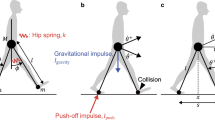Abstract
Older adults and people with various neurological diseases need some external assistance even during normal walking. Amongst various factors, due to a decrease in the muscle strength, they are not able to produce a large force that significantly affects the pre-swing phase of their gait cycle, an important determinant of walking speed. While there is significant work done on active assistance for walking, almost no work has been reported on the effect of torsional spring and combinations of torsional and linear springs as a mode of passive assistance. OpenSim was used to model the effects of linear and torsional spring-based passive assistance on the total metabolic energy and ankle moment during human gait. A total of six conditions were simulated out of which five gave satisfactory findings. Particularly, a combination of ankle torsional and gastrocnemius path springs showed the largest reduction in the peak total metabolic energy and peak plantar flexor moment during the pre-swing phase of the gait cycle, suggesting that such passive assistance could be used as an effective mode of support for walking.
Access this chapter
Tax calculation will be finalised at checkout
Purchases are for personal use only
Similar content being viewed by others
References
Chale-Rush A, Guralnik JM, Walkup MP et al (2010) Relationship between physical functioning and physical activity in the lifestyle interventions and independence for elders pilot. J Am Geriatr Soc 58:1918–1924
Judge JO, Davis III RB, Ounpuu S (1996) Step length reductions in advanced age: the role of ankle and hip kinetics. J Gerontol Med Sci 51A(6):M3O3–M312
Graf A, Judge JO, Ounpuu S, Thelen DG (2005) The effect of walking speed on lower extremity joint powers among elderly adults who exhibit low physical performance. Arch Phys Med Rehabil 11:2177–2183
Kang HG, Dingwell JB (2000) Dynamics and stability of muscle activations during walking in healthy young and older adults. J Biomech 42:2231–2237
Karamanidis K, Arampatzis A (2005) Mechanical and morphological properties of different muscle-tendon units in the lower extremity and running mechanics: effect of aging and physical activity. J Exp Biol 208:3907–3923
Kerrigan DC, Lee LW, Nieto TJ, Markman JD, Collins JJ, Riley PO (2000) Kinetic alterations independent of walking speed in elderly fallers. Arch Phys Med Rehabil 81:730–735
Kerrigan DC, Lee LW, Collins JJ, Riley PO, Lipsitz LA (2001) Reduced hip extension during walking: healthy elderly and fallers versus young adults. Arch Phys Med Rehabil 82:26–30
Koster A, Penninx BW, Newman AB (2007) Lifestyle factors and incident mobility limitation in obese and non-obese older adults. Obesity (Silver Spring) 15:3122–3132
Murray MP, Duthie Jr EH, Gambert SR, Sepic SB, Mollinger LA (1985) Age-related differences in knee muscle strength in normal women. J Gerontol 40:275–280
Sepic SB, Murray MP, Mollinger LA, Spurr GB, Gardner GM (1986) Strength and range of motion in the ankle in two age groups of men and women. Am J Phys Med 65:75–84
Perera S, Patel KV, Rosano C et al (2016) Gait speed predicts incident disability: a pooled analysis. J Gerontol A Biol Sci Med Sci 71:63–71
McGibbon CA (2003) Toward a better understanding of gait changes with age and disablement: neuromuscular adaptation. Exerc Sport Sci Rev 31:102–108
Perry J, Burnfield JM (2010) Gait analysis: normal and pathological function. SLACK Incorporated
Zoss A, Kazerooni H (2006) Design of an electrically actuated lower extremity exoskeleton. Adv Robot 20(9):967–988
Wang ZX (2010) Raytheon launched XOS2 second generation exoskeleton device. Light Weapons 23:24–44
Spencer A (2010) The report of production display for “HULC” made in Lockheed Martin. Available: http://www.lockheedmartin.com. Accessed May 2013
Veneman JF, Ekkelenkamp R, Kruidhof R, et al (2005) Design of a series elastic- and Bowden cable based actuation system for use as torque-actuator in exoskeleton-type training. In: Proceedings of the 9th international conference on rehabilitation robotics, 28 June–1 July, Chicago, IL, USA
Berkelman P, Rossi P, Lu T, Ma J (2007) Passive orthosis linkage for locomotor rehabilitation. In: Proceedings of the 2007 IEEE 10th international conference on rehabilitation robotics, June 12–15, Noordwijk, The Netherlands
Collins SH, Wiggin MB, Sawicki GS (2015) Reducing the energy cost of human walking using an unpowered exoskeleton. Nature 522
Hong MB, Shin YJ, Wang JH (2014) Novel three-DOF ankle mechanism for lower-limb exoskeleton: kinematic analysis and design of passive-type ankle module. In: IEEE/RSJ international conference on intelligent robots and systems (IROS 2014) Sept 14–18, 2014, Chicago, IL, USA
Umberger BR, Gerritsen KGM, Martin PE (2003) A model of human muscle energy expenditure. Comput Methods Biomech Biomed Eng 6(2):99–111
Author information
Authors and Affiliations
Corresponding author
Editor information
Editors and Affiliations
Rights and permissions
Copyright information
© 2021 Springer Nature Singapore Pte Ltd.
About this paper
Cite this paper
Anand, R.S., Kanekar, N., Guha, A. (2021). Modeling the Effects of Linear and Torsional Spring Based Passive Assistance on Human Gait. In: Sen, D., Mohan, S., Ananthasuresh, G. (eds) Mechanism and Machine Science. Lecture Notes in Mechanical Engineering. Springer, Singapore. https://doi.org/10.1007/978-981-15-4477-4_11
Download citation
DOI: https://doi.org/10.1007/978-981-15-4477-4_11
Published:
Publisher Name: Springer, Singapore
Print ISBN: 978-981-15-4476-7
Online ISBN: 978-981-15-4477-4
eBook Packages: EngineeringEngineering (R0)




